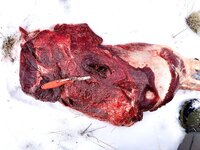Odds of that happening with a 300wm? lol yeah that's the point.
I’ve have seen “total bullet failures” with 300 win mags quite a few times. This includes Barnes, Hornady GMX, Failsafes, multiple lead soft points- bonded and not, HPBT’s, etc. This is where numbers come in- kill enough, you see it with all of them.
I realize you love your 6.5 and more power to you if it works for you,
I do not “love” any chambering or calibers. I use them all. Out of the first hundred deer I killed with rifles, 98 of them were killed with 30cal magnums. The first elk I killed was with a 300wm. I have killed a rather large number of game animals with every chambering from 22-338, exactly for 25 cal has only been a few. What I’m posting is reality of tracking what each of those bullets did terminally, the animals reaction, and the shooters performance.
but if you compare the same projectile but heavier and faster there's never a downside and there are times where it can make a difference. Apparently the one in a million event here would be one of them.
There are several downsides to “heavier and faster”. Shooting ability being the major one. As recoil goes up, everything else goes down in performance- group sizes, hit rates, spotting your own shots, etc, etc. There is no one that shoots two identical rifles, one in 224 and one in 338wm, with the same mechanical precision, to the same level.
Tracking hundreds (plural) of animals killed from antelope to elk- the most screwups, wounding, and rodeos come from the rifles with the most recoil and concussion; and the tougher the bullet is, the longer the game travels after being hit. As recoil and concussion goes down, so to do that bad shots.
I have no emotion to this. The highest shot to recovery rate of anything I/we have seen had been a 22cal/77gr TMK combo. In well over 200 game animals, from muzzle contact to well beyond what almost anyone would attempt, there has been one poor shot that was followed up with a clean shot, and no lost animals. That’s from antelope, deer, bear, elk, and moose. The next highest shot to recovery rate has been 6mm’s. Then, 6.5mm’s. Etc, etc. The lowest shot to recovery rate- that is poor shots that result in wounded animals not being found, or significantly long tracking jobs has been with 30cal magnums. Again, not referencing a one off, or a couple of animals; hundreds of game animals.
eta: Elk shoulder is not a prairie dog and I'm not going to bother even discussing that, we can agree to disagree.
I never said anything about a prairie dog.
So you can not post photos of what I asked for? It would be really simple for someone that disagrees to show a tape measure of an elk scapula that shows there is 20+ inches of muscle covering the bone, and also show that the scapula is thicker than standard cardboard.
Here is an elk “shoulder” with an exit on the backside. That is not from a small elk, and you can use the Havalon as a reference. From the larger RM bull I have seen, to the lungs is less than 8” from any part of the shoulder, to any part of the lungs.

There is no agreeing or disagreeing- there is reality. Tell me how a elk shoulder is materially different than any other shoulder? How many inches of muscle is it to the scapula, and how thick is the scapula?





